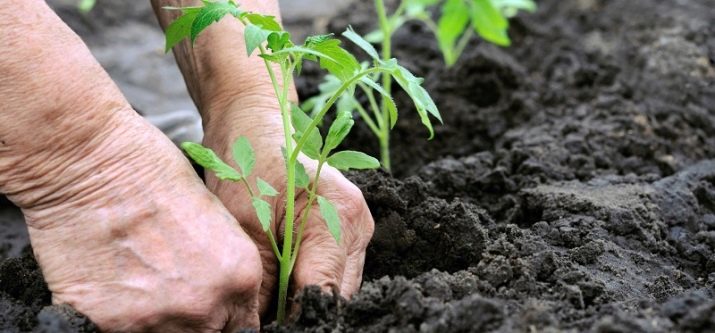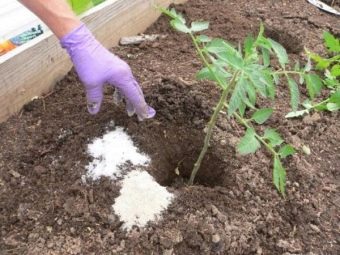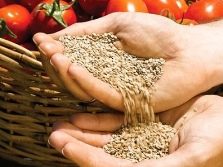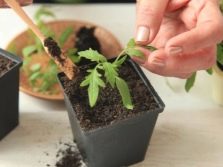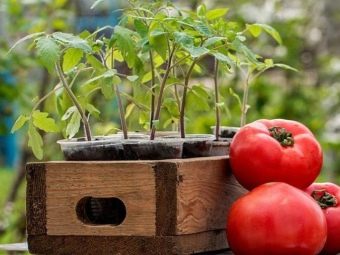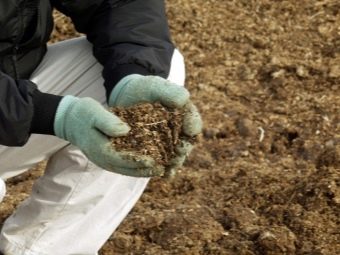Tomato seedlings do not grow well: we understand the causes and correct the situation
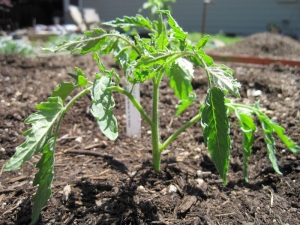
Tomatoes - one of the most beloved vegetable crops, which many grow on their summer cottages.But far from always seedlings take root well in the open field. The reasons for this may be very different, and to eliminate each of them there are special means and methods.
Not everyone knows how to use them correctly. Detailed instructions on how to protect tomatoes from diseases and accelerate their growth will be presented in this article.
Why it happens?
There are several reasons why a tomato does not grow well in open ground. One of them is improper feeding seedlings. If this process is not given due attention, then the soil will lack a number of necessary substances, as a result of which negative processes will occur.
- Small leaves of faded color and the general sickly type of a plant testifies to shortage of nitrogen. Also the plant stems become thin.
- Marble green color gets in case of lack of magnesium.
- About the deficiency of potassium say twisted leaves of seedlings. This problem is easy to solve if potassium sulfate is added to the soil in the amount specified in the instructions.
- When on the bottom side of the sheet plates acquire a reddish tint, this means that they need phosphorus.
- Growth of tomatoes stops due to lack of iron.
Another reason for the deterioration of the state of plants in open ground are errors in the dive process. A dive is the elimination of the central part of the root in order to enable the lateral root processes to germinate.
Usually the procedure is carried out during the separation of seedlings from each other in order to avoid the intertwining of their roots in the process of further growth.
As a rule, the dive process must be done very carefully. But not all gardeners do it. As a result, the root system may be damaged, and the growth of the seedling will stop. In this situation, you must wait until the damaged root processes regenerate. Also, problems arise if, after a picking, immediately begin to fertilize the soil, and also water the seedlings with cold water. If during the first five days after the procedure you do not monitor the condition of the soil, the plants may die.
A very frequent reason for stopping the growth of seedlings are mistakes made during the care of plants.
- Wrong seed selection. It is important to pay attention to the fact that the maximum age of seeds should not exceed 5 years. The younger the seeds, the greater the likelihood that they will germinate normally with proper care.
- Tomatoes are very sensitive to temperature. In the room where the seedlings are grown, must be warm (at least +24 degrees Celsius). If the apartment is cold, use a heater or periodically turn on the lamp above the plants.
- The soil may not be nutritious for good growth of seedlings. To saturate it with nutrients, it is recommended to buy special substrates. Also, do not use the soil taken from the garden - it is better to buy a special one, which is designed specifically for growing tomatoes.
- Balance in soil moistening is important. It is undesirable to irrigate too much, but also the ground should not be dry, so watering the seedlings should be every 7 days.
- Sometimes pets harm seedlings. If the cat urine gets into the seedling ground, then the further growth of the culture will most likely stop. Therefore, it is important to put the plants in a place that will not be available for pets.
- Sometimes the condition of seedlings worsens due to stress.which they experience during the transplanting process. To facilitate this procedure, it is recommended to use sodium humate.
Diseases
In addition to the above problems, the growth of tomatoes can stop due to a number of diseases that crop plants often suffer from. Consider the most common diseases of tomatoes.
- Black leg - a disease of the fungal type. Its symptoms are darkening of the lower part of the stems, drying of the plant and the process of rotting in the root system. The danger of this disease in its infectiousness, therefore, if it appeared in one seedling, the likelihood of its soon occurrence in the others is great. To prevent the mass development of the disease, remove diseased plants and move them to a separate container. Then you should take a new soil, mix it with calcined sand and wood-type ashes. Then, a new primer is sprayed with a special preparation called Fundazol, according to the instructions. After this, the soil cannot be moistened until it finally dries out.
- Another disease of the fungal type is septoria. Its main symptom is the appearance of yellow-white spots on the leaves of tomatoes. These spots are framed by a dark-colored border. The plant can infect through the soil. Patients seedlings are finally removed, and healthy ones should be transplanted, warming up carefully and fertilizing the soil before sowing.
- A serious negative consequence of waterlogging can be rot in the root system. It also appears when the seedlings have been under conditions of low temperature for a long time. In this case, you need to dig up the plants, thoroughly rinse the roots with potassium permanganate and plant the tomatoes in a new soil. As an analogue of potassium permanganate, Fitosporin can be used.
- Slow growth and wilt occurs due to a disease such as fusarium. Seedlings begin to turn yellow and wither from the bottom leaves. This disease most often ends with the death of sprouts, but in some cases their transplant helps.
If the process of growth of seedlings is in place, it is not always necessary to refer specifically to the disease. No less serious cause can also be insect parasites.
Pests
Often, tomato diseases are attributed to the effects of various types of pests. The spider mite is common among parasites, as well as earwigs and woodlice. To cope with them, you should use special means, such as "Aktellik" and "Karbofos." In order not to cause the seedlings even more harm, before using the drugs, be sure to read the instructions on their packaging.
The main part of the pests attacks the plants not when they are grown on a window sill near the window, but when they are already transplanted into open ground. Young seedlings can be affected by some unpleasant parasites, due to which the plants grow slowly or even die.
- White fly. It can be seen from the cluster of white midges around the plants. They form yellow spots on the green. To get rid of the parasite, you should use garlic decoction, wetting the soil with cold water (such insects are afraid of temperature contrasts).
- Colorado potato beetle eats tomato leaves. To deal with it should be using ash and soap solution.
- Garden scoop It is especially dangerous for plants recently planted in the ground. On the back of their leaves, she lays a huge number of eggs, the larvae of which subsequently feed on greens. For the prevention of the appearance of the pest should fight weeds immediately after planting seedlings. And to get rid of scoops will help chemicals, such as "Bitoxibacillin."
How to accelerate growth?
If seedlings froze in the process of development or show signs of discomfort, it is necessary to stimulate its growth and check the condition of the soil. There are various methods of helping plants: some gardeners prefer to use chemical agents, others adhere to popular recipes.
Preparations
There are many ready-made preparations and growth stimulants that will contribute to improving the state of the soil and, consequently, a more rapid process of seedling development.The effect of the use of such funds is reduced to the fact that plant growth improves, their immunity increases, they also become more resistant to the effects of various natural disasters.
Two weeks before transplanting into open ground, tomatoes can be poured with Atlet. It will help strengthen the growth of the root system and slightly hold back the development of the part of the plant above the ground.
But in order for the above-ground part to grow better, the seedlings are watered with a mixture of water and hydrogen peroxide. Peroxide is added in proportions of 4 tablespoons to 2 liters of water. Moreover, this composition is not only watered the plants, but also sprayed.
To replenish the supply of phosphorus must be diluted in a bucket of water 12 grams of superphosphate.
To remove the gray color of the plants and restore their growth, you should remove them in the shade and pour in a special solution: 25 grams of sodium sulfate is added to one bucket of water.
For tomato seedlings, there are several popular drugs that stimulate growth and improve the condition of plants.
- "Epin-extra" minimizes the content of nitrates, it also enhances the resistance of plants to weathering. It is usually applied after the seeds have risen to strengthen the roots. Ampule "Epin" stir in 5 liters of water and pour the plant under the root with this composition. Store the diluted drug can be only during the day in a dark place.
- A rather powerful growth stimulator that promotes the formation of flower ovaries is "Zircon". And also it improves the immunity of seedlings. It is introduced into the soil after sprouting, and tomatoes are sprayed a couple of times a month. To have with the help of this tool a beneficial effect on the roots, you can use it in combination with Etamon.
- Toxic but effective stimulant is "Kornevin". It is used at the stage of soaking seeds before planting. Dilute the product in proportion 1 gram per liter of water. For 6 hours, the seeds should be in this solution so that the seedlings are earlier and healthier.
- To increase the yield and resistance to temperature changes, a stimulator is applied. "Silk". In 2 liters of boiled water should be diluted product according to the instructions, and then soak the seeds in it for two hours.
Folk remedies
Many experienced gardeners know how to prepare various mixtures at home to feed the plants, and what ingredients should be used to improve their growth. Independently you can help seedlings in several proven ways.
- If there is little nitrogen in the soil, 4 grams of urea should be diluted in 10 liters of water and the plants should be watered.
- As a nutrient for the root system, you can use bird droppings. It is usually filled with water and infused for several days. This mixture is poured under the root of the plant.
- Infusion on the egg shell is prepared from the shell of 3 or 4 eggs. It is shredded in a plastic bottle and poured with water, without closing the lid. After 5 days, when water is infused and enriched with the necessary substances, seedlings are watered. For every plant, 1 teaspoon of such fertilizer is needed per day.
- To make the soil looser and thus help the plant in the absorption of nutrients, you can use yeast. For 2 liters of water you need 10 grams of yeast (fresh). After a day, when the mixture is infused, this fertilizer is added to the soil after it has been watered.
- To enrich the soil with potassium can, using a banana peel. In a can of 3 liters put the skin of 4 bananas and pour warm water over the temperature. After 3 days, you can use the infusion, bringing it into the soil after watering.
- To improve the growth of tomato seedlings in February and in early spring, the lack of light must be filled with special fluorescent lamps.
Useful tips
To seedlings develop without problems, it is important to listen to the advice of experienced gardeners.
- A heated greenhouse and warmed window sills are suitable as the most suitable place for sapling. But do not place the seedling container near batteries and heaters.
- The soil, in addition to the disinfecting components and nutrients, should include the following mandatory elements: soil, humus, rotted sand, peat.
- To avoid future fungal diseases, the seeds must be hardened. To do this, they are kept in the fridge before planting. Also, such diseases will help prevent hydrogen peroxide.
- When warming comes, seedlings should be periodically taken out onto the balcony. So you can gradually accustom the seedlings to the natural environment and reduce their stress when transplanting into open ground.
- A day before picking, it is recommended to moisten the soil. Moreover, watering should be done in three stages.
- As a preventive measure against the formation of diseases, spraying can be prepared, which include milk.
- If you notice that some of the plants become sluggish, do not put them under the open rays of the sun, dispense a quantity of light so that the seedlings are restored.
- To prepare tomato seedlings for planting in open ground, it can be watered with rain or melt water.
- It is necessary to monitor the condition of the soil, especially the level of its acidity. For this, a special indicator is used. 1⁄2 glasses of water is mixed with a handful of earth, then an indicator that measures acidity is dropped into the mixture. The red color of the strip, showing increased acidity, suggests that before planting the plants need to liming the soil using eggshell.
- When using chemical growth stimulants, be sure to wear gloves, as some products may be toxic.
Thus, taking into account all the features of growth and the availability of necessary conditions for tomatoes, it is possible to keep seedlings healthy throughout the entire germination period, minimize their stress when transplanted into open ground and prevent the occurrence of dangerous diseases and the appearance of pests.
With all the above recommendations, you can grow a truly rich crop of tomatoes. On what to do if the seedlings of tomatoes after planting in the ground almost does not grow, see the following video.

